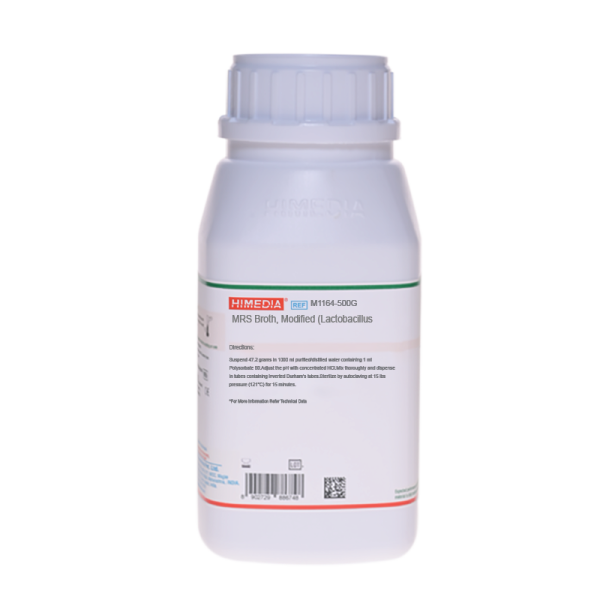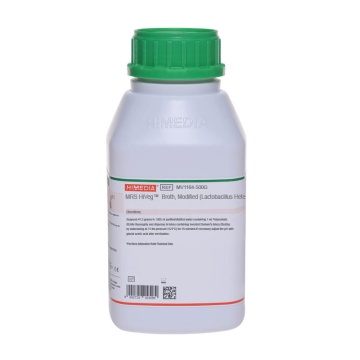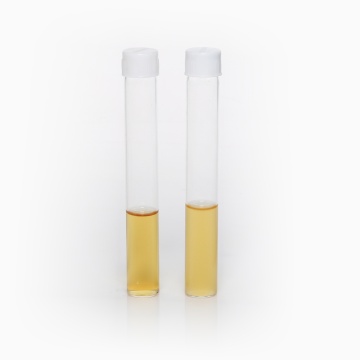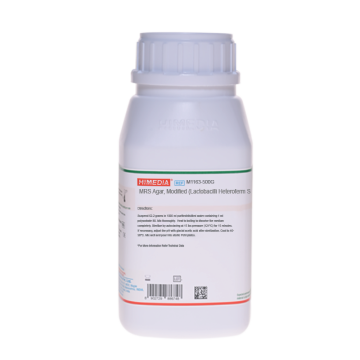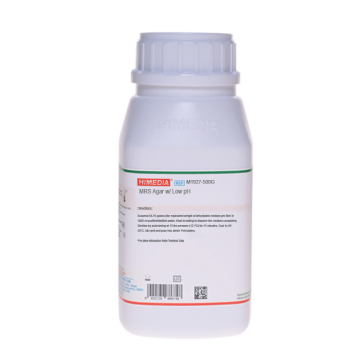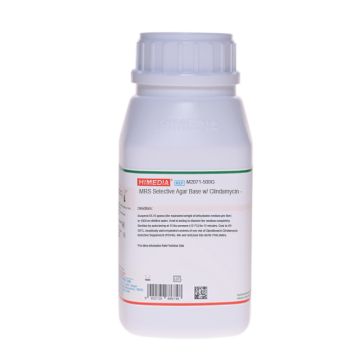 Your enquiry has been submitted
Your enquiry has been submitted
MRS Broth, Modified (Lactobacillus Heteroferm Screen Broth)
Acid Producing Microorganisms#CC293D
Intended Use:
Recommended for isolation and cultivation of Lactobacillus species from salad dressings.
Composition**
| Ingredients | g/L |
|---|---|
| Dextrose (Glucose) | 20.000 |
| Proteose peptone | 10.000 |
| Yeast extract | 5.000 |
| Sodium acetate | 5.000 |
| 2-Phenylethyl alcohol | 3.000 |
| Ammonium citrate | 2.000 |
| Dipotassium hydrogen phosphate | 2.000 |
| Magnesium sulphate | 0.100 |
| Manganese sulphate | 0.050 |
| Bromocresol green | 0.040 |
| Cycloheximide | 0.004 |
| Agar | 15.000 |
Final pH (at 25°C): 5.5±0.2
**Formula adjusted, standardized to suit performance parameters
Directions
Suspend 62.2 grams in 1000 ml purified/distilled water containing 1 ml polysorbate 80. Mix thoroughly. Heat to boiling to dissolve the medium completely. Sterilize by autoclaving at 15 lbs pressure (121°C) for 15 minutes. If necessary, adjust the pH with glacial acetic acid after sterilization. Cool to 45-50°C. Mix well and pour into sterile Petri plates.
Principle And Interpretation
Mayonnise, cooked starch-based dressings resembling mayonnise and pourable dressings are the types of salad dressings available. Microorganisms in salad dressings come from the ingredients from manufacturing equipments and from air. The microflora causing salad dressing to spoil seems quite restricted and consists of few species of Lactobacillus, Saccharomyces and Zygosaccharomyces. MRS Agar, Modified (Lactobacillus Heteroferm Screen Agar) recommended by APHA (1), is used for the isolation and cultivation of Lactobacillus species from salad dressings (2).
MRS Agar, Modified is the modification of MRS medium of deMan et al (3). Proteose peptone and dextrose supply nitrogen, carbon and other elements essential for the growth of Lactobacilli. Polysorbate 80 a mixture of oleic esters, supplies fatty acids required by Lactobacilli. Ammonium citrate, sodium acetate, 2-phenylethyl alcohol and cycloheximide inhibit gram-negative organisms, moulds and certain gram-positive bacteria. Certain yeasts are also suppressed because of presence of cycloheximide. Bromocresol green is the pH indicator, which under acidic conditions, changes colour from green to yellow.
Type of specimen
Food samples
Specimen Collection and Handling:
Inoculate 1 ml of 1:10 dilutions of the dressing sample into three MRS Broth, Modified (M1164) tubes. Incubate at 32°C for 72 hours ± 2 hours. Positive tubes have trapped CO2 in the Durham's tubes or bubbles of CO2 clinging to the inside of the tube and a colour change from green to yellow indicating acid production. These presumptive cultures can be confirmed by streaking on MRS Agar, Modified plates. After use, contaminated materials must be sterilized by autoclaving before discarding.
Warning and Precautions :
Read the label before opening the container. Wear protective gloves/protective clothing/eye protection/face protection. Follow good microbiological lab practices while handling specimens and culture. Standard precautions as per established guidelines should be followed while handling specimens. Safety guidelines may be referred in individual safety data sheets.
Limitations :
Limitations
- Individual organisms differ in their growth requirement and may show variable growth patterns on the medium.
- Further biochemical tests must be carried out for complete identification.
Performance and Evaluation
Performance of the medium is expected when used as per the direction on the label within the expiry period when stored at recommended temperature.
Quality Control
Appearance Light yellow to bluish grey homogeneous free flowing powder
Gelling Firm, comparable with 1.5% Agar gel
Colour and Clarity of prepared medium Green coloured clear to slightly opalescent gel forms in Petri plates
Reaction Reaction of 6.22% w/v aqueous solution at 25°C. pH : 5.5±0.2
pH 5.30-5.70
Cultural Response
Cultural characteristics observed in presence of 5-10% Carbon dioxide (CO2) after an incubation at 35-37°C for upto 3 days.
| Organism | Inoculum (CFU) | Growth | Recovery |
|---|---|---|---|
| Lactobacillus rhamnosus ATCC 9595 | 50-100 | luxuriant | >=50% |
| Lactobacillus acidophilus ATCC 4356 (00098*) | 50-100 | luxuriant | >=50% |
| Lactobacillus fermentum ATCC 9338 | 50-100 | luxuriant | >=50% |
| $ Lactiplantibacillus plantarum ATCC 8014 | 50-100 | luxuriant | >=50% |
Key : * Corresponding WDCM numbers, $ Formerly known as Lactobacillus plantarum
Storage and Shelf Life
Store dehydrated and the prepared medium at 2-8°C. Use before expiry date on the label. On opening, product should be properly stored dry, after tightly capping the bottle in order to prevent lump formation due to the hygroscopic nature of the product. Improper storage of the product may lead to lump formation. Store in dry ventilated area protected from extremes of temperature and sources of ignition. Seal the container tightly after use. Product performance is best if used within stated expiry period.
Disposal
User must ensure safe disposal by autoclaving and/or incineration of used or unusable preparations of this product. Follow established laboratory procedures in disposing of infectious materials and material that comes into contact with sample must be decontaminated and disposed of in accordance with current laboratory techniques (4,5).
Reference
- Salfinger Y., and Tortorello M.L., 2015, Compendium of Methods for the Microbiological Examination of Foods, 5th Ed., American Public Health Association, Washington, D.C.
- Smittle R. B. and Flowers R. M., 1982, J. Food Protection, 45:977.
- DeMan J. D., Rogosa M. and Sharpe M. E., 1960, J. Appl. Bacteriol., 23:130.
- Isenberg, H.D. Clinical Microbiology Procedures Handbook 2nd Edition.
- Jorgensen, J.H., Pfaller, M.A., Carroll, K.C., Funke, G., Landry, M.L., Richter, S.S and Warnock., D.W. (2015) Manual of Clinical Microbiology, 11th Edition. Vol. 1.
| Product Name | MRS Broth, Modified (Lactobacillus Heteroferm Screen Broth) |
|---|---|
| SKU | M1164 |
| Product Type | Regular |
| Physical Form | Powder |
| Origin | Animal |
| Packaging type | HDPE |
| References | 1.Vanderzant C. and Splittstoesser D. F., (Eds.), 1992, Compendium of Methods for the Microbiological Examination of Foods,3rd Ed., APHA, Washington, D.C.2.Smittle R. B. and Flowers R. M., 1982, J. Food Protection, 45:977.3.DeMan J. D., Rogosa M. and Sharpe M. E., 1960, J. Appl. Bacteriol.,23:130. |
| Customized Product Available | No |



